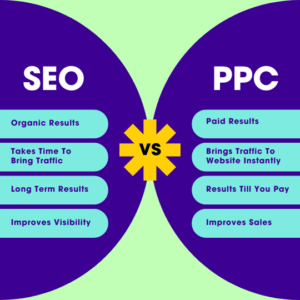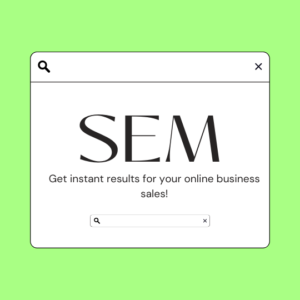Search Engine Optimization and Search Engine Marketing are two fundamental topics in the domain of digital marketing. We have outlined the differences and similarities between the two because business owners struggle to understand them: “SEO is free, and SEM costs money”. SEO is about getting your website seen organically in search results, while SEM is about paying to appear there.
In this blog, we have completely explained the differences and similarities between SEO and SEM and discussed how to effectively use both strategies to enhance your online presence.
Difference Between SEO and SEM
- SEO is a long-term strategy that gradually builds brand value and drives sales, whereas SEM provides immediate results through well-optimized advertisements.
- SEO results appear organically in search engine rankings, based on relevance and quality, while SEM results are displayed at the top or bottom of the search page, labeled as ‘sponsored’.
- SEO is much cheaper than SEM and builds a lasting value that is less vulnerable to sudden changes. SEM costs are based on the bidding charges taken by search engines which depends on the industry.
- SEO increases trustworthiness and credibility of a business over time whereas SEM is for instant and precise results.
Search Engine Optimization: A Focused Guide

Search Engine Optimization (SEO) involves making strategic changes to your website to improve its visibility and ranking, aiming to position it above competitors within your industry without any cost.
It is really necessary to do SEO on your website because when a new website is launched on SERP, it does not have much visibility. To get noticed and rank well by search engine bots; there is only one way, that is SEO.
SEO has 4 main areas to optimize:
-
Keyword Research
Keyword research involves identifying relevant phrases and terms that potential users might type into search engines when looking for the products or services your website offers.
The goal is to discover keywords that align with your website’s content and user search intent to enhance your site’s relevance and visibility. One needs to find keywords that have good search volume with less difficulty to rank; while meeting the relevance.
-
On Page Optimization
On page optimization is the process in which individual web pages of the website are changed as per search engine recommendations to rank higher and get more clicks on the website.
For Example- Optimizing the product page, we will add the product keywords to the url, heading and product description while keeping the content relevant and engaging for users.
Get our simple SEO on-page checklist for a perfect SEO strategy for your webpages on your website:
- Quality Content- The content on webpages should be relevant, informational and engaging and most importantly original to the queries users are searching over the SERP.
- Adding Relevant Keywords- Relevant Keywords should be added to the meta tags, headings, sub headings and content in a natural manner. The practice of adding relevant keywords to the content should not look like keyword stuffing. It should be done in a natural manner so that it increases the readability and rankings.
- Internal Links- Internal linking is the practice of linking the keywords about which you have more information on other blogs to give the reader a detailed version of every relevant term on your website. They should not move to other sources to get deep into the terms relevant to the topic.
- Use schema markup-structured data: Structured data gives additional context to search engines about what’s on your page. It may be the reason for deep search listings called rich snippets, which could improve your visibility and click-through rates.
All of these combined will greatly enhance your site’s SEO, making it much easier to find and friendlier for both search engines and users.
-
Off-page SEO and Link Building
Off-page SEO and link building refer to anything that happens “outside” of your website-from getting backlinks to improving your social media presence and generally gaining trust and authoritativeness.
Naturally, the most headline part of this process is link building-the gaining of links from other websites, preferably with higher authority.
The value of link building lies in the quality, not the number of links. Try reaching out to authoritative sites within your industry always for a link request, create good and comprehensive content that will attract links organically, write guest posts of high quality, and surround sound SEO practices.
Depending on the performance and influence of these link sources, you will be growing your brand awareness and boosting your followers on social platforms.
Technical SEO
The goal of technical SEO is to optimize the technical nature of your website for better crawling and indexing capabilities of the search engines.
This includes website speed optimization, its mobile friendliness, and overall user experience.
- Focus on a mobile-friendly website
Already, most of the people access the web through mobile devices; thus, having a website that is mobile-friendly is no longer open to negotiation.
- Search engines will grant special importance to sites that are mobile-friendly.
Use responsive design so that your site can configure its settings according to the size of different screens.
Test out your site on many devices to ensure usability.
Optimize images and other media to load faster on mobile devices.
- XML sitemap creation in a good structure.
The XML sitemap will be responsible for showing the search engine about your site structure and basically letting them know about all the great stuff that is on your website. It’s like a roadmap that shows where the most important places are in your website.
Each and every website must have a sitemap. The sitemap can be created with an XML sitemap tool or created with Yoast SEO.
Create the sitemap and submit to Google Search Console and Bing Webmaster Tools.
Smoothen the road ahead with HTTPS.
Changes to sitemap may be done routinely based on addition of new content to the site.
- SSL implementation
HTTPS encrypts data from the user’s browser to your website and hence increases the security of your website. Search engines give more priority to an HTTPS site compared to an HTTP one.
Get an SSL certificate from a trusted Certificate Authority. Install an SSL certificate on your server. Update your website URLs to use https instead of http
- Improve page speed & Core Web Vitals
Pagespeed is crucial to the user experience of all and in ranking on SERP. Core Web Vitals are the set of metrics about the speed, responsiveness, and visual stability of a webpage that Google thinks is most important to the overall user experience.
What is Search Engine Marketing?

Search Engine Marketing, a strategic approach involving various paid services, enhances a website’s visibility on search engine result pages.
The most common way of doing SEM is through pay-per-click (PPC) advertisements, where money is deducted from your account every time a user visits the website and pays the platform owner.
Google SERP is the most popular type of SEM platform where businesses run their Google ads. Website owners bid on the keywords relevant to their niche. The website is visible on top of the search engine result page with a sponsored tag on the selected product/service keywords. Any user who searches for the keyword comes across the website.
Pay-Per-Click seems like it should be easy, but it is not. Many activities, including keyword research, ad creation, and optimization, need to be done so that the ad reaches the correct audience and the business gets a high ROI.
1. Keyword Research
There are no specific instructions required for PPC Keyword Research. But it is used in ads instead of web pages, so think of it that way and choose relevant phrases. By bidding on well-researched keywords, one can easily appear on relevant search queries by users, bringing a good amount of traffic to the website. Let’s get into the details of PPC bids in the next step,
2. PPC Bid
PPC bidding involves setting the highest price you are willing to pay for each click on your ad. There are two ways to bid: manual or automated.
-
Manual bidding:
Manual Bidding is the process of manually setting maximum bids for each keyword. This keeps all the spending control in your hands and helps you bid on specific keywords on a specific campaign with a particular cost.
-
Automated bidding:
If you are not an ads expert, automated bidding can help you a lot. Automated bidding is the process in which ad bids are placed based on artificial intelligence and machine learning algorithms. These algorithms consider various factors, including keyword performance, ad quality, and competition.
3. Selecting Target Audience
In search engine marketing, the target audience is the way in which you select the audience for your ads. Choosing the correct audience could change the game for your business.
As a marketer, you have the power to select your audience by choosing your website’s demographic, interest, behavior, and previous viewership.
Get a detailed insight into what comes under which selection:
- Demographics: It involves choosing the age, gender, and location of the people your ad should be visible to.
- Interest: It involves targeting the audience based on their prior searches on SERPs, i.e., their interests and behavior.
- Retargeting: It is a technique in which the audience that has visited your online store(website) is the one whom you target by repeatedly showing your ads.
If you sell medicines, you will target ads to users who have shown interest in particular medicines or doctor visits.
You will also retarget users who visited your site but didn’t make a purchase, encouraging them to return and complete their transaction.
4. Designing Ads
It sounds like ad designing- creating ads that could attract your users.
Ad copy should be interesting, relevant, and eye-catching to the audience. It should match their interests and hobbies while positioning the CTA in the right position.
How to create an ad copy:
- Catchy Headlines: Create headlines that grab attention and include your primary keywords.
- Persuasive Copy: Put all the benefits of your product/service in the ad copy with the correct CTAs.
- High-Quality Images: In display ads, make sure to use clear and eye-catching images.
5. Ad Assets
Ad assets include site links, callouts, and structured snippets. You can create engaging and effective ads that resonate with your target audience by selecting and combining the right assets.
SIte Links: Add links to different pages on your website, such as product pages, and special offers.
Callouts: Focus should be on the benefits of your product or services.
Structured Snippets: Providing additional details such as product specifications and services offered.
Conclusion
From the above explanation it will be clear to the business owners what is the difference between SEO and SEM. While SEO and SEM are powerful tools, they are not a one-time solution. Consistent effort and continuous optimization are essential to maintain your online visibility and achieve long-term success.
FAQs
- Can I do SEM/SEO on my own?
SEO/SEM requires time and effort so if you are a business owner and want to save your time and effort by just keeping an eye to your marketing strategy you should hire an expert. Or else, put on that extra effort and DIY.
- How long does it take to see results from SEO and SEM?
SEO takes time but gives a brand value for the long term while SEM is an instant result process.
- Should I focus on SEO or SEM first?
The best approach depends on your business goals and resources. If you’re looking for immediate results, SEM can be a good starting point. However, for long-term sustainability, SEO is essential.